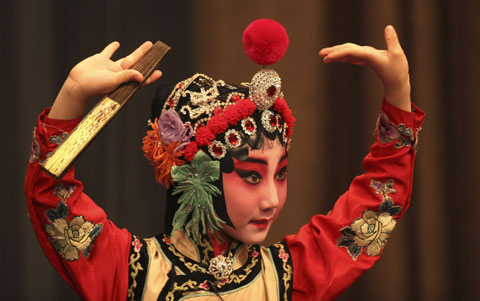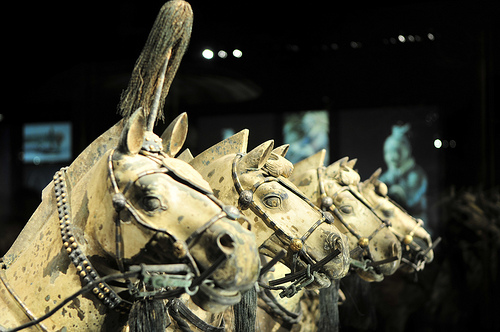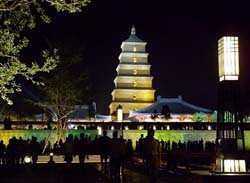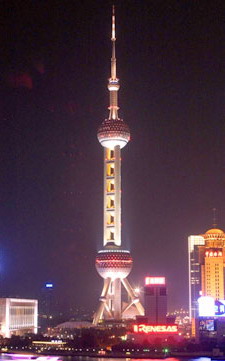| Day 1 Beijing ( ) |
| Upon arrival at the Beijing airport, pickup by our English speaking tour guide and drive to hotel. Free at leisure for the rest of the day. Recommend you to take a walk alone on Wangfujing Streeet, it is the most busy shopping area in Beijing. (optional)
|
Wangfujing Streeet | It is the grandest shopping area in Beijing, congested with modern shopping malls, such as the Oriental Plaza, Wangfujing Department Store, etc. It is also home to a wealth of hotels and specialty shops. Around is an afflicted snack street where you can enjoy the most authentic Beijing snacks. |
|
 |
| [ Optional ] Train Z19 Beijing to Xian: Z19 train is the fastest and most modern long distance trains in China, running on routes Beijing to Xian. Leave Beijing at 21h18, arrive Xian at 08h19 next day. These trains are soft class only (no hard class) with 4-berth ordinary soft class sleepers, 2-berth deluxe soft class sleepers with private toilet, restaurant car. |
|
| Day 2 Beijing ( B,L,D ) |
|
Tian An Men Square | As the largest city plaza in the world, it is of great cultural significance for its seeing of several key events in Chinese history. Today here are always sightseers and kite-flyers. Most visit at dawn or dusk to see the flag raising and lowering conducted by the PLA. | Peking Opera | With a history of 160 years, Peking Opera, extolled as “Oriental Opera”, is representative of all operas in China. Full of Chinese cultural traditions and tidbits, the opera presents the audience with touching stories, beautiful paintings, exquisite costumes, graceful gestures and martial arts. | Forbidden City | For almost 500 years, the Forbidden City served as the home of 24 Emperors and their households, and the ceremonial and political center of the Chinese imperial government. It was listed by UNESCO as a World Cultural Heritage Site in 1987. | Summer Palace | The Summer Palace deserves your visit to her exquisite buildings, long corridor, and beautiful bridges. Her shoreline pathway makes an excellent run or walk for you. It was a luxurious imperial garden for royal families to rest and entertain in Chinese Qing Dynasty. |
|
 |
| [ Optional ] Peking Opera: With a history of 160 years, Peking Opera, extolled as “Oriental Opera”, is representative of all operas in China. Full of Chinese cultural traditions and tidbits, the opera presents the audience with touching stories, beautiful paintings, exquisite costumes, graceful gestures and martial arts. |
|
| Day 3 Beijing ( B,L,D ) |
|
Sacred Way | It was originally built to lead to Changling Tomb as a symbol of the passed emperor’s journey to heaven in their afterlife. Alongside the Sacred Road are 12 pairs of animal marble figures such as lions, elephants and 6 pairs human marbles such as generals and public officials. | Ming Tombs (Changling) | Changling Tomb is the largest and the most well-preserved one of the 13 Ming Tombs. Emperor Zhu Di, the third emperor of Ming Dynasty, and his Empress are co-buried in this grave. The 32 giant pillars in the Ling’en Hall, Changling’s main building, remain as solid as before after over 500 years. | Peking Roast Duck | With its long history, Peking roast duck is well known among both domestic and overseas customers. The duck is hung in the oven and roasted by flame burning from fruit-wood. It takes about 45 minutes for the duck to be done. The finished duck is characteristic with crispy skin, tender meat and the f…… | Badaling Great Wall | This sector is the first opened to tourists and the best preserved. Fully restored in 1957, it can be seen how it looked when it was first built in the Ming dynasty. Set in a steep, forested mountain range, Badaling offers superb views and good hiking experience. |
|
 |
| [ Optional ] Terra Cotta Warriors and Horses Museum: Terracotta Warriors is the underworld terracotta army of Emperor Qin Shihuang (the first unifier of China, 259BC-210BC). It’s reputed as the Eighth Miracle of the World. Now the Terracotta Museum consists of Pit 1, Pit 2, Pit 3 and Pit 4 as well as the Hall of the two bronze chariots and horses. |
|
| Day 4 Beijing ( B,L ) |
| Transfer to Beijing West Train station for the train (soft sleeper class, 4 berths in one compartment) to Xian. Train No.: Z19 (leaves Beijing at 21h24, arrives Xian at 08h25 next day. 11 hours). Stay overnight on the train. |
Train Z19 Beijing to Xian | Z19 train is the fastest and most modern long distance trains in China, running on routes Beijing to Xian. Leave Beijing at 21h18, arrive Xian at 08h19 next day. These trains are soft class only (no hard class) with 4-berth ordinary soft class sleepers, 2-berth deluxe soft class sleepers with privat…… | Temple of Heaven | It was the place where the Emperor of the Ming and Qing dynasties would worship heaven and pray for good harvests. Built first in 1420, the Temple of Heaven is a precious example of China 's ancient architectural art and the largest design for worshipping heaven in the world. | Beijing Zoo | The must-see area of Beijing Zoo is the famous Panda House, You can see lovely Giant Panda and lesser panda. Lakes and gardens abound in the zoo complex which is a weekend destination for families. | Hutong Tour | The Hutongs is the old narrow paths where common people used to live. You will be taken by rickshaws to visit ordinary Beijing families living in these compound houses. Rickshaws are actually three wheeled bicycles. There are fleets of them circling around the Hutongs. |
|
 |
| [ Optional ] Big Wild Goose Pagoda: It was built in 652 during the Tang Dynasty and currently boasts height of seven stories. It’s said that Master Xuan Zang built this pagoda to house the Buddhist scriptures and relics he had brought back from India. |
|
| Day 5 Xian ( B,L ) |
| Arrive Xian railway station at 08h25 in the morning. Pikup by our English speaking tour guide from the train station and transfer to the hotel in Xian. Check in the hotel, freshup and have breakfast in the hotel, then you will start your city tour. |
Great Mosque | The Great Mosque is one of the largest and best-kept Islamic mosques in China, which was originally built in 742 AD during the Chinese Tang Dynasty(618-907). It combined Islamic culture with Chinese traditional architecture seamlessly and became most featured and renowned mosques in China. | Big Wild Goose Pagoda | It was built in 652 during the Tang Dynasty and currently boasts height of seven stories. It’s said that Master Xuan Zang built this pagoda to house the Buddhist scriptures and relics he had brought back from India. | Terra Cotta Warriors and Horses Museum | Terracotta Warriors is the underworld terracotta army of Emperor Qin Shihuang (the first unifier of China, 259BC-210BC). It’s reputed as the Eighth Miracle of the World. Now the Terracotta Museum consists of Pit 1, Pit 2, Pit 3 and Pit 4 as well as the Hall of the two bronze chariots and horses. |
|
 |
| [ Optional ] Oriental Pearl TV Tower: With 467.9 meters in height, It is the forth tower in height in Asia and the sixth tallest in the world, opposite to the Bund. Its transparent elevator will take you to the top, which will offer a quiet good view of Shanghai. The basement houses the Shanghai Municipal History Museum. |
|